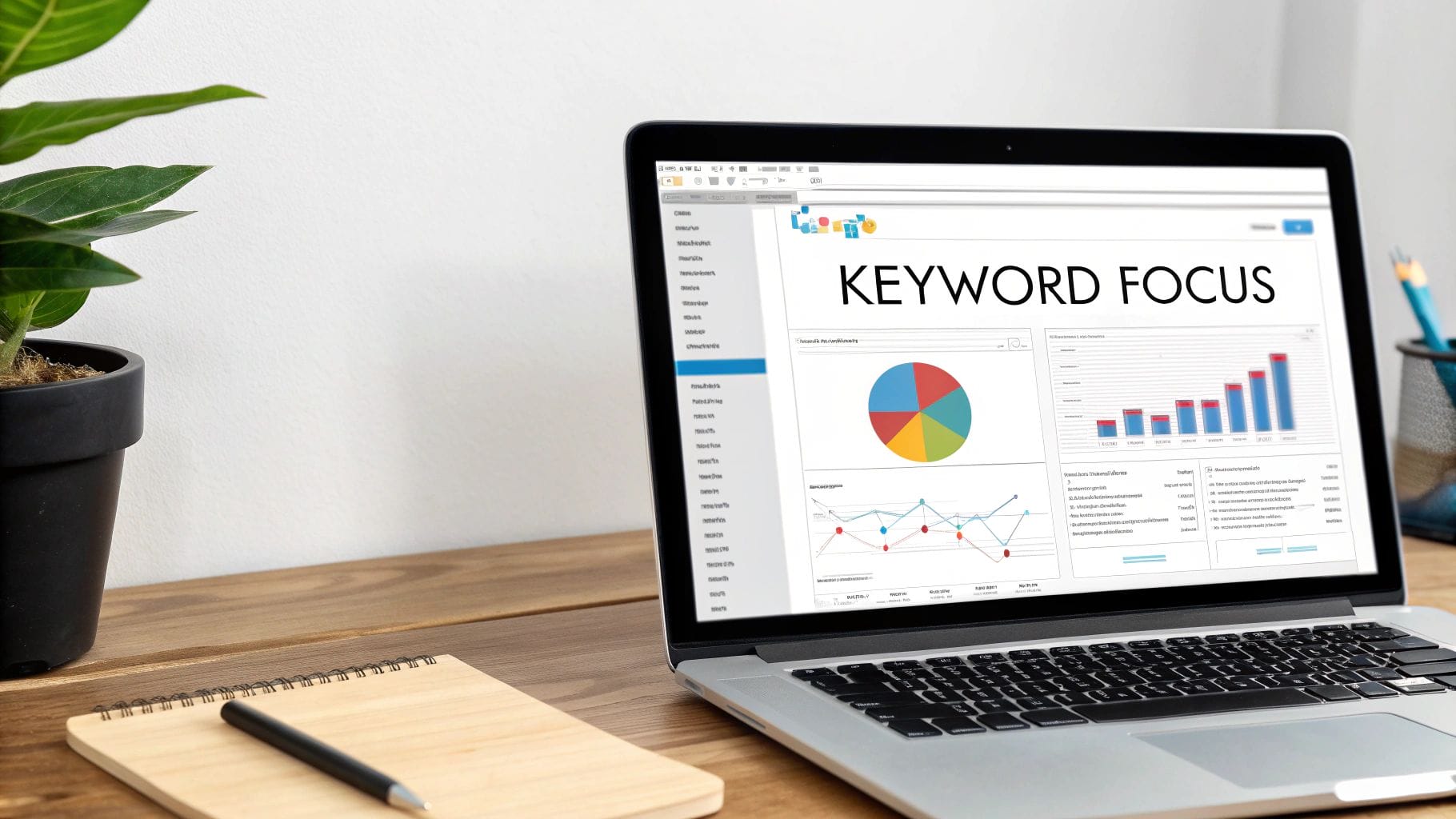Decoding SEO Fundamentals Without Getting Lost

Improving your website’s SEO isn’t about chasing the latest fads. It’s about grasping the core principles that drive visibility in search results. This requires a shift in thinking, leaving behind outdated methods for a more strategic approach. It means understanding how search engines process your content and, importantly, how users engage with it. These interactions provide valuable signals that influence your search rankings.
Understanding the Core Principles of SEO
A robust SEO strategy rests on a few key pillars. High-quality content is essential. This means more than just well-written text; it means content that genuinely meets the needs and interests of your audience.
A positive user experience is also crucial. A website that’s easy to navigate, loads quickly, and offers valuable information will naturally draw more engagement, boosting SEO performance.
Finally, authoritative backlinks are a strong signal of trust and authority. These backlinks act like endorsements from other websites, telling search engines your content is valuable and worth ranking higher.
The Importance of Google’s Algorithms
Google’s impact on website SEO is undeniable. Google dominates the search market, holding a 91.54% share as of 2025. It’s the starting point for 92% of global internet searches. Learn more about these statistics.
Optimizing your website for Google’s algorithms is essential for global visibility. Understanding Google’s 200+ ranking factors, especially the top three: high-quality content, superior page experience, and authoritative backlinks, is the key to a winning SEO strategy.
Why User Signals Matter
Search engines are getting better at measuring user satisfaction. They track metrics like bounce rate, time on page, and click-through rate to understand how users interact with your website.
A high bounce rate suggests users aren’t finding what they need, while a long time on page signals engaging and relevant content. Focusing on user experience isn’t just good for your visitors; it’s vital for SEO.
Keyword Research and Optimization
Knowing what users search for is crucial for targeting the right keywords. Effective keyword research means finding relevant terms with decent search volume but manageable competition.
This often involves focusing on long-tail keywords: longer, more specific phrases targeting niche audiences. Once you’ve identified your keywords, integrate them naturally into your content, headings, and meta descriptions.
Avoid keyword stuffing, which can hurt your rankings. Instead, create valuable content that truly answers user intent. This approach to keyword research and optimization makes your content discoverable and engaging, setting the stage for long-term SEO success.
Creating Content That Actually Ranks (And Converts)

Creating content for SEO isn’t just about keywords. It’s about a strategy that satisfies both search engines and your readers. This is the heart of content marketing: crafting engaging, informative content that draws readers in and encourages them to explore your site.
Identifying High-Potential Topics
Finding the right topics is crucial. This starts with keyword research to understand what your audience is searching for. Tools like SEMrush and Ahrefs can uncover relevant keywords with good search volume and manageable competition. Instead of targeting a broad term like “SEO,” focus on a long-tail keyword like “how to improve website SEO for local businesses.” This targeted approach attracts a more engaged audience.
Addressing Content Gaps
Identifying content gaps is another effective SEO strategy. These are topics your competitors haven’t fully covered. This creates an opportunity to fill the void and attract a larger audience share. Tools like BuzzSumo help analyze competitor content and find areas where you can offer unique perspectives or more comprehensive information. This builds authority and sets your content apart.
Writing for Both Search Engines and Humans
Once you’ve chosen your topic, start writing. Balancing keyword optimization and reader engagement is key. Incorporate relevant keywords naturally, but avoid keyword stuffing, which can hurt your rankings. Focus on high-quality content that provides real value to your audience. Include your target keyword in headings, subheadings, and naturally within the text. This helps search engines understand your content while keeping it readable for visitors.
Content Length and Its Impact
One of the most effective ways to boost SEO is by focusing on content length and quality. Content over 3,000 words gets three times more traffic than the average length of around 1,400 words (based on 2025 data). Long-form content also gets four times more social shares and 3.5 times more backlinks, which are vital for rankings. This shows Google prefers in-depth, comprehensive content. Create detailed pieces that explore a topic thoroughly. Find more detailed statistics here.
Let’s explore how content length impacts SEO performance:
To illustrate this further, let’s look at a comparison table:
Content Length Impact on SEO Performance
This table compares how different content lengths affect key SEO metrics including traffic, social shares, and backlinks.
| Content Length | Traffic Increase | Social Shares | Backlink Generation | Average Time on Page |
|---|---|---|---|---|
| Under 1,000 words | Low | Low | Low | Short |
| 1,000 – 2,000 words | Moderate | Moderate | Moderate | Medium |
| 2,000 – 3,000 words | High | High | High | Long |
| Over 3,000 words | Very High | Very High | Very High | Very Long |
As you can see, longer content generally performs better across various SEO metrics. This reinforces the importance of creating comprehensive, in-depth content.
Structuring Your Content for Success
Content structure significantly impacts SEO. Use headings (H1-H6) to divide content into logical sections, improving navigation for both search engines and readers. Use bulleted lists for key takeaways or instructions. Use tables to compare data or present information visually. A well-structured page improves readability and crawlability, helping search engines understand and index your content. Use clear, concise language, avoid jargon, and break complex ideas into digestible pieces.
Balancing Depth with Readability
While in-depth content excels in search results, balance depth with readability. Use short paragraphs, clear headings, and visuals like images and videos. These elements improve aesthetics and break up text, making it easier to scan and digest. This combined SEO approach ensures your website ranks well and resonates with your audience.
Technical SEO: Building the Foundation You Can’t See

Engaging content is key for attracting users. But what keeps your website visible? It’s technical SEO, the unseen backbone of your online presence. Often overlooked, this crucial aspect can determine your SEO success or failure. Think of it as the foundation of a house: without a solid base, even the most beautiful structure is vulnerable.
Conducting a Technical SEO Audit
A technical SEO audit thoroughly analyzes your website’s technical elements that influence search engine visibility. This process pinpoints and diagnoses issues that might be holding back your rankings. This involves examining everything from your website’s site architecture and mobile-friendliness to its page speed and security. A site with broken links or slow loading times, for example, will likely rank lower than a site with a solid technical foundation.
Here’s how to perform a basic audit:
- Crawl your website: Use a tool like Screaming Frog to simulate how search engines crawl your site, helping you identify potential problems.
- Analyze your sitemap: A well-structured sitemap is essential. Make sure yours accurately represents your website and includes all important pages.
- Check for broken links: Broken links (404 errors) negatively impact user experience. Identify and fix these to improve crawlability and user satisfaction.
- Analyze page speed: Use tools like Google PageSpeed Insights to assess your site’s loading time and spot opportunities for improvement. Page speed is a known ranking factor, influencing both user experience and search visibility.
- Review mobile-friendliness: With the majority of searches happening on mobile devices, ensure your website is responsive. Provide a seamless mobile experience and test your site with Google’s Mobile-Friendly Test.
Prioritizing Technical SEO Fixes
Not all technical issues have the same impact. Some affect your rankings more significantly than others. Therefore, prioritizing your fixes is crucial. Focus on issues that offer the greatest potential gains. For example, fixing a broken sitemap is likely more impactful than optimizing images for alt text.
Here’s a prioritization framework:
- High Priority: Address issues that hinder crawling and indexing, such as sitemap errors, broken links, and server errors.
- Medium Priority: Fix issues affecting user experience like slow page speed, mobile-friendliness, and security issues.
- Low Priority: Address minor issues like missing meta descriptions or unoptimized images after tackling the more critical problems.
Building a System for Ongoing Technical SEO
Technical SEO isn’t a one-and-done task. It requires continuous effort. Search engine algorithms constantly evolve, and your website must adapt. Establish a system for regular maintenance and monitoring, including scheduled audits, performance tracking, and staying informed about best practices.
Here’s a simple system to implement:
- Regular Audits: Perform a full technical SEO audit every six months to a year, or after significant site changes.
- Performance Monitoring: Regularly monitor key metrics like crawl errors, page speed, and mobile usability.
- Continuous Improvement: Keep up with the latest SEO trends and best practices for ongoing optimization.
A solid technical SEO foundation benefits both search engines and users. It creates a platform for your content to shine, boosting rankings, driving traffic, and ultimately, improving business outcomes. Technical SEO is an essential piece of the website optimization puzzle.
On-Page Optimization That Moves the Needle

Technical SEO builds a solid foundation, but on-page optimization is where the magic happens. It’s how you refine your content to connect with both search engines and your audience. This means strategically shaping elements like title tags, headings, and images to reach your full ranking potential. It’s not just a checklist; it’s about understanding the connection between your content and how search engines interpret it.
Crafting Compelling Title Tags
Your title tag is the first thing users see in search results. It’s a quick summary of your content that needs to grab attention and accurately describe the page. Top SEO teams carefully create title tags, testing different versions to improve both ranking and click-through rate. This means using relevant keywords while keeping the titles engaging and easy to read. Instead of a basic title like “SEO Tips,” try something more specific like “5 Proven SEO Tips to Boost Your Website Traffic in 2024.”
Structuring Content With Strategic Headings
Beyond the title tag, heading tags (H1-H6) are key for structuring your content. Think of your H1 as the main title of your page, clearly stating the topic. Subsequent headings (H2-H6) break down the content into smaller sections, guiding both users and search engines through the information. This organized structure makes it easier to read and helps search engines understand the hierarchy of information. Using relevant keywords in your headings further emphasizes the topic and improves your ranking chances.
The Power of Internal Linking
Internal links connect the different pages on your website. They guide users to related content and distribute page authority, an important ranking factor. Strategic internal linking means linking relevant pages with descriptive anchor text. For example, if you have a post about keyword research and another about on-page optimization, link them using text like “learn more about keyword research” and “discover on-page optimization techniques.” This strengthens the topical relevance of both pages and helps search engines understand the connection between them.
Optimizing Visual Content for SEO
Images and videos improve user experience and offer valuable SEO opportunities. Alt text describes images to search engines. Don’t just stuff keywords into alt text; write descriptions that accurately reflect the image and naturally include relevant keywords. This helps users with screen readers and helps search engines understand your images.
Schema Markup for Rich Results
Schema markup enhances search results with rich snippets. It helps search engines understand the specifics of your page, like product details, reviews, or events. Schema.org provides a vocabulary for structuring data that can increase visibility and improve click-through rates.
Page Structure and User Experience
A well-structured page is vital for both user experience and how search engines crawl your site. Search algorithms prioritize easy-to-navigate pages. This means using clear headings, short paragraphs, and visuals. How users behave and how search engine results pages (SERPs) evolve significantly impacts SEO strategies. Over 99% of users don’t go past the first page of search results, making competition for page one fierce. The click-through rate (CTR) drops sharply after the first position: position one gets about 39.8% of clicks, while positions two and three get 18.7% and 10.2%, respectively. SeRanking provides more detailed statistics. This highlights the need to optimize every part of your on-page SEO to boost visibility and attract organic traffic.
Let’s explore how SERP positions correlate with click-through rates. The table below illustrates this important relationship, emphasizing the need to rank high in search results.
SERP Position and Click-Through Rate Correlation
| SERP Position | Click-Through Rate (%) | Visibility Impact | Traffic Potential |
|---|---|---|---|
| 1 | 39.8 | Highest | Very High |
| 2 | 18.7 | High | High |
| 3 | 10.2 | Medium | Moderate |
| 4 | 6.1 | Medium-Low | Moderate-Low |
| 5 | 3.8 | Low | Low |
| 6-10 | <3 | Very Low | Very Low |
This table clearly shows how crucial it is to achieve top rankings. The higher your page ranks, the more visible it is and the more traffic it’s likely to receive. Focus your SEO efforts on reaching those top spots for maximum impact.
Building a Backlink Portfolio That Actually Matters
On-page optimization is essential, but backlinks remain crucial for improving website SEO. However, not all backlinks are created equal. Some can boost your search engine rankings, while others can harm your site’s authority. This section explores building a backlink portfolio that truly elevates your website. This means moving beyond simply getting any link to strategically earning high-quality endorsements from trusted sources.
Identifying Link Opportunities With Real Impact
The first step is identifying link opportunities that offer real value. This means looking beyond easily acquired links and focusing on links from authoritative sites in your niche. These high-quality backlinks carry significant weight with search engines, acting as strong votes of confidence in your website. It’s like getting a recommendation from a leading expert – it carries more weight than an anonymous review.
Creating Link-Worthy Content
Attracting valuable backlinks starts with creating link-worthy content. This means content that’s not only informative and well-written, but also original, insightful, and preferably, data-backed. Consider incorporating diverse formats like infographics, original research reports, or comprehensive guides offering unique perspectives. Proprietary data, for example, within original research, is very likely to attract links from others in the same industry.
Outreach That Respects Relationships
Building effective backlinks involves outreach. However, avoid spammy practices. Instead, cultivate genuine relationships with website owners and influencers in your industry. Personalized outreach that shows real interest in their work is much more effective than generic requests. This means tailoring your message, demonstrating your understanding of their audience and how your content aligns with their interests.
Evaluating Link Quality Beyond Basic Metrics
It’s important to assess the quality of the links you acquire. Metrics like Domain Authority (DA) provide a general indication of a website’s authority, but it’s crucial to look beyond these basic metrics. Consider factors like the website’s relevance to your niche, the context of the link, and the overall credibility of the linking site. A link from a highly authoritative but irrelevant site may not be as valuable as a link from a smaller, more relevant site.
Content Formats That Earn Editorial Links
Certain content formats are more likely to earn valuable editorial links, which are given organically because other websites find your content useful and worthwhile. These formats include:
- Original Research and Data Studies: These provide unique insights that other websites want to reference.
- In-depth, Comprehensive Guides: Offering detailed resources on specific topics can establish your website as an authority in your field.
- Visually Appealing Infographics and Data Visualizations: These make complex information easily digestible and shareable.
- Expert Roundups and Interviews: Featuring insights from multiple industry leaders creates valuable and highly shareable content.
Focusing on these formats increases your chances of earning high-quality backlinks.
Building Sustainable Link Building Systems
Developing sustainable link building systems is essential for long-term success. This means creating a repeatable process for identifying link opportunities, creating high-quality content, and conducting personalized outreach. This might involve using tools like Ahrefs to monitor mentions of your brand or competitors, setting up alerts for industry news, or creating a database of potential link partners. A systematic approach ensures consistent progress without resorting to unsustainable or risky tactics. Remember, link building is an ongoing process, not a one-time fix. It takes time, effort, and a commitment to creating truly valuable content. By prioritizing quality over quantity and building genuine relationships, you can build a backlink portfolio that substantially contributes to your website’s SEO success.
User Experience: The SEO Factor You’re Overlooking
While technical SEO and compelling content are essential, user experience (UX) plays an increasingly vital role. Imagine crafting a highly informative article that’s difficult to read or navigate. Users will quickly leave, sending negative signals to search engines. This section explores how UX directly impacts search engine rankings and offers optimization strategies for improved website SEO.
Core Web Vitals: Beyond Basic Speed
Core Web Vitals are key metrics Google uses to assess user experience. These focus on loading performance, interactivity, and visual stability. Optimizing these is crucial for a positive user experience.
Largest Contentful Paint (LCP): This measures the loading time of the largest page element, essentially when a user perceives the page as ready. Aim for an LCP of 2.5 seconds or less.
First Input Delay (FID): FID measures browser response time to a user’s first interaction. A low FID ensures a responsive website. A good FID is 100 milliseconds or less.
Cumulative Layout Shift (CLS): This metric assesses visual stability, preventing unexpected element shifts during loading. A low CLS avoids frustration. Aim for a CLS of 0.1 or less.
Going beyond basic speed means delivering content quickly and ensuring immediate usability. Optimize images, use efficient code, and prioritize above-the-fold content to improve Core Web Vitals.
User Interaction Signals and Ranking Stability
User interactions offer valuable data to search engines. Metrics like bounce rate, time on page, and click-through rate (CTR) indicate user satisfaction. A high bounce rate suggests unmet needs, while longer time on page signals engagement. Improving these helps search engines recognize content relevance and value, contributing to ranking stability. For example, immediate return to search results after clicking your page signals unmet needs.
Navigation: Balancing SEO and Conversions
Website navigation impacts both SEO and conversions. Clear, intuitive navigation helps users and search engines find information. Organize content logically with relevant categories and subcategories, improving crawlability for efficient indexing.
Optimized navigation also enhances user experience, facilitating information discovery and potentially increasing engagement and conversions. A well-structured sitemap with clear internal links strengthens navigation and aids content discovery.
Identifying and Fixing UX Issues that Impact SEO
Identifying SEO-affecting UX issues requires technical analysis and user feedback. Tools like Google Search Console highlight technical issues, while user testing reveals navigational challenges or content gaps. For example, mobile users struggling with forms could indicate a UX issue negatively affecting SEO.
Accessibility and SEO: A Growing Relationship
Accessibility and SEO are increasingly connected. Website accessibility improves user experience for everyone and can positively impact SEO. Many accessibility best practices, like descriptive alt text for images and proper heading structure, directly benefit SEO. Search engines prioritize websites offering positive experiences for all users, including those with disabilities.
Measuring and Optimizing for User Signals
Top websites measure and optimize user signals valued by Google. They track dwell time, page views, and conversion rates to understand user interaction with content. Analyzing this data reveals areas for improvement, enhancing UX and boosting SEO performance. This iterative process of measuring, optimizing, and re-measuring is crucial for sustained SEO success. A high exit rate on a specific page, for instance, might suggest content or design issues. Addressing these can improve UX and potentially boost SEO.
Measuring What Matters: Beyond Basic Rankings
SEO success isn’t solely about reaching the top of search engine results pages (SERPs). It’s about generating real business results. Improved rankings are a positive sign, but they are just one indicator of success. To genuinely grasp the effectiveness of your SEO strategy, you need to go beyond superficial metrics and focus on connecting your SEO efforts to demonstrable business value.
Developing Custom Dashboards for Genuine Impact
A custom SEO dashboard is crucial for monitoring the metrics that truly align with your specific business goals. These might include organic traffic, conversion rates, leads generated, or even revenue directly driven by organic search. A well-designed dashboard offers a centralized view of your progress, giving you actionable insights instead of just raw, undigested data. For example, tracking keywords alongside conversion rates can reveal which search terms bring in the most valuable traffic.
Attributing Conversions to Specific SEO Efforts
Knowing which SEO activities contribute most to conversions is essential for maximizing ROI. This means tracking conversions back to specific keywords, individual content pieces, or particular technical improvements. For instance, a noticeable increase in conversions after implementing schema markup could suggest the effectiveness of that specific change. This level of detail allows you to refine your SEO strategy by concentrating on the tactics that yield the highest return. Tools like Google Analytics can be very helpful in attributing value to specific SEO activities.
Reporting SEO Value to Stakeholders
Showing the value of SEO to stakeholders requires clear and concise reporting. Focus on metrics that directly resonate with business objectives, like leads, sales, or revenue. Instead of simply presenting ranking data, illustrate the impact of those rankings on actual business growth. For example, highlighting a 10% increase in sales directly attributed to organic search traffic from optimized blog content clearly communicates the value of your SEO program.
Identifying and Tracking Leading Indicators
Successful SEO teams are proactive, not reactive. By identifying and tracking leading indicators, like backlink growth, content quality improvements, or technical enhancements, you can anticipate future ranking changes and adjust your strategy accordingly. This forward-thinking approach helps maintain consistent growth and adapt to algorithm updates.
Benchmarking Against Competitors
Understanding your website’s performance relative to your competitors provides invaluable context. Benchmarking involves comparing key metrics like organic traffic, keyword rankings, and backlink profiles to identify areas for improvement and opportunities to outperform the competition. This competitive analysis can inform your SEO strategy and uncover areas where you can gain a significant edge. For example, pinpointing keywords where your competitors rank but you don’t can reveal valuable opportunities to expand and refine your content strategy.
Iterative Improvement Based on Actionable Insights
SEO is a continuous process of refinement. By analyzing your data, you can identify what’s working, what’s not, and where to best focus your efforts. This iterative approach allows you to consistently improve your website’s SEO performance and maximize your return on investment. This means regularly revisiting your SEO strategy, testing different approaches, and making adjustments based on the data you gather. This data-driven approach ensures continuous improvement and positions you for long-term success.
By shifting focus from basic ranking data and concentrating on these key areas, you can transform your SEO strategy from a tactical checklist into a powerful engine for business growth. This comprehensive approach to SEO measurement ensures your efforts are not only visible in search results but also contribute significantly to your bottom line.
Notifyio helps boost brand credibility and digital marketing performance with social proof and conversion optimization. Visit today to find actionable insights, informative articles, and expert perspectives to maximize your marketing ROI.




Leave a Reply